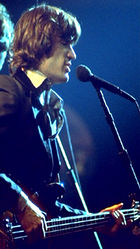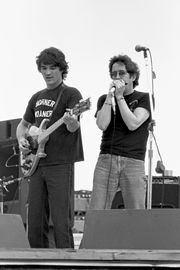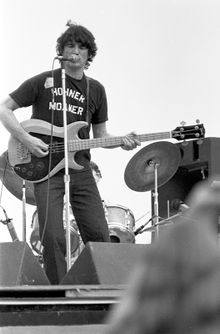Rick Danko
| Rick Danko | |
|---|---|
|
|
|
| Background information | |
| Birth name | Richard Clare Danko |
| Born | December 29, 1942 |
| Died | December 10, 1999 (aged 56) |
| Genres | Rock, blues, country rock, folk rock, folk |
| Occupations | Musician, songwriter, producer |
| Instruments | Vocals, bass, double bass, fiddle, guitar, mandolin, accordion, trombone, piano |
| Years active | 1955–1999 |
| Labels | Capitol, Arista, Rykodisc, Woodstock, Breeze Hill |
| Associated acts | The Band Ronnie Hawkins Bob Dylan Ringo Starr and His All-Starr Band Danko, Fjeld, Andersen |
| Notable instruments | |
| Fender Bass VI Fender Jazz Bass Ampeg AUB-1 Gibson Ripper Bass Custom semi-hollow 5-string bass |
|
Richard Clare "Rick" Danko (December 29, 1942 – December 10, 1999) was a Canadian musician and singer, best known as a member of The Band.
Contents |
Early years (1942–1967)
The third of four sons, Danko was born in Green's Corners, Ontario, a farming community outside of the town of Simcoe, to a musical family of Ukrainian descent.
Growing up in front of the family radio (as his future bandmates also did), he was exposed to country and R&B music at an early age. His musical heroes included Hank Williams and, later, Sam Cooke. He also drew inspiration from the music of his oldest brother, Maurice "Junior" Danko. After entering the first grade in school, he performed on a 4 string tenor banjo.[1]
Danko formed the Rick Danko Band at the age of 12 or 13,[2] and at 14, he left school to pursue music. At 17, already a five-year music veteran, he booked himself as the opening act for Ronnie Hawkins, an American rockabilly singer whose group, The Hawks, were considered to be one of the best in Canada. (Drummer Levon Helm had joined with Hawkins' band in 1957 before venturing north, and lead guitarist Robbie Robertson, had joined in 1960.)
Hawkins invited Danko to join The Hawks as rhythm guitarist. Around this time, Hawks bassist Rebel Paine was fired by Hawkins, who, wasting no time, had Danko learn bass, given help by other members of the band. By September 1960, he was Hawkins's bassist, using the Fender VI six-string bass, then switching to a Fender Jazz Bass.
Soon joined by pianist Richard Manuel and organist/reedsman Garth Hudson, The Hawks played concerts with Hawkins through mid-1963. While an altercation that year between Danko and Hawkins led Danko, Helm, Robertson, Manuel, and Hudson (as well as reedsman Jerry Penfound and occasional singer Bruce Bruno) to finally give their two-weeks' notice, the group had been planning to leave Hawkins and strike out together as a band without a frontman, as a team of equal members.[3]. Initially performing as the Levon Helm Sextet (because Helm had accumulated the most time with Hawkins), they later became The Canadian Squires before finally being called Levon and the Hawks.
Playing a circuit that stretched in an arc from Ontario to Arkansas, they became known as "the best damn bar band in the land." By 1965, with two singles under their belt (and Penfound and Bruno long gone), they met the legendary blues harmonicist and vocalist Sonny Boy Williamson and planned a collaboration with him as soon as he returned to Chicago.
Unfortunately for the group (who went on to play a four-month stand of gigs in New Jersey immediately afterward), Williamson died within days of their meeting, and the collaboration never happened. Around the same time, however, Bob Dylan contacted them, and they became his backing group. The nature of Dylan's tour, however, became too much for Helm, who departed in November. Through May 1966, Dylan and the remaining foursome (together with pick-up drummers, including actor/musician Mickey Jones) traveled across America, Australia, and Europe, playing new versions of Dylan classics. After the final shows in England, Dylan retreated to his new home in Woodstock, New York, and the Hawks joined him shortly thereafter.
The Band (1968–1977)

It was Danko who had found the pink house on Parnassus Lane, just off Stoll Road, in Woodstock, New York. He, Hudson, and Manuel quickly moved in, with Robertson ensconcing himself nearby. The Band's musical sessions with Dylan were moved to the basement of the house, beginning around May, 1967 through October, of the same year. That basement hangout was dubbed, "Big Pink". However, by October, Dylan and his backing group parted ways after his motorcycle crash; with Dylan eventually going to Nashville to record John Wesley Harding and The Hawks beginning demo recordings for their first album. Songs such as "Yazoo Street Scandal," "You Don't Come Through," "Ferdinand The Imposter," "Beautiful Thing," and "Words And Numbers" were completed by January 1968 (with Helm returning to the fold sometime between August and November); and their manager, Albert Grossman, securing them a recording deal with Capitol Records.
Working over the next few months, the five-piece band churned out what would become their debut album, Music From Big Pink. Touring behind the album, however, was not to be; Danko was severely injured in a car accident, breaking his neck and back in six places, which put him in traction for months. (It would be April 1969 before the group finally debuted in concert as The Band, at Bill Graham's Winterland in San Francisco.)
By this time, they were already hard at work on their eponymous second album. On that record, sometimes known as "The Brown Album," Danko sang what would become two of his signature songs—and two of the group's best-loved classics: the reflective yet whimsical story-song "When You Awake" and the achingly poignant "The Unfaithful Servant." Both songs exemplified Danko's talents as a lead singer and showcased his naturally plaintive, almost mournful, voice, which would become part of the signature vocal style for which he was known.
The Band's albums were defined by each member—Robertson's lyrics and guitar work, Helm's "bayou folk" drumming and Southern voice, Manuel's Ray Charles-like vocals and complex keyboard rhythms, and Hudson's arrangements on an assortment of instruments. But Danko's iconic tenor, his on-top-of-the-melody harmonies, and his percussive, melodic bass-playing style were an integral part of the group's sound. In an interview with Guitar Player, Danko cited bassists James Jamerson, Ron Carter, Edgar Willis, and Chuck Rainey as his musical influences. He eventually moved from the Fender Jazz Bass to an Ampeg fretless model and later a Gibson Ripper for The Last Waltz.
Later years (1977–1999)

Although The Band had performed its farewell concert ("The Last Waltz") at Winterland in November 1976, Danko had no intention of calling it quits. Clive Davis offered him a contract with Arista Records, making him the first Band member to record a solo album. Issued in 1977, his self titled début featured each of his bandmates in addition to Ronnie Wood, Eric Clapton, and Doug Sahm. The album was primarily recorded at The Band's California Studio, Shangri-La. The poor showing of the album, however (it barely cracked the Billboard 200), destined it for rarity status, and although he recorded a follow-up album, Danko was dropped from Arista. (The follow-up album, presumed lost for many years, was finally released as a part of 2005's Cryin' Heart Blues.)
In early 1979 Danko briefly opened shows for Boz Scaggs in selected venues.
From 1983 to 1999, Danko alternated between a reformed version of The Band featuring Helm, Hudson, and guitarist Jim Weider (and, from 1983 to 1986, Manuel); a busy solo career; and a number of collaborations, including award-winning work with singer/songwriter Eric Andersen and Norway's Jonas Fjeld. The trio was known as Danko/Fjeld/Andersen.
In 1989, Danko toured with Levon Helm and Garth Hudson as part of Ringo Starr's first All-Star Band.
He sang on the Pink Floyd songs "Comfortably Numb" and "Mother", the former with Van Morrison, Roger Waters, and Levon Helm, and the latter with Helm and Sinéad O'Connor on July 21, 1990, in Roger Waters' stage production of The Wall Concert in Berlin.
Danko recorded demos and made a number of appearances on albums by other artists throughout the 1980s and 1990s, and in 1997, he released Rick Danko in Concert. Two years later, a third solo album (Live on Breeze Hill) was released, and Danko was busy at work on a fourth (Times Like These) at the time of his death.
In the meantime, The Band, wothout Robertson, recorded three more albums of their own, and Danko teamed with Fjeld and Andersen for two trio albums, Danko/Fjeld/Andersen in 1991 and Ridin' on the Blinds in 1994. By the late 1990s, his lifestyle was taking its toll however, particularly his drinking and indulging in a mix of harder drugs and painkillers, the result of the serious car accident in 1968. He continued to be on prescribed opiates, including morphine, throughout the remainder of his life, Danko's health problems were later compounded by rapid weight gain in the mid 1990s. By 1997, he was chronically obese. That same year, after playing a string of shows with the Band with one at Carnagie Hall in NYC Rick was looking forward to the future during a conversation at the Parker Mereidian Hotel Rick spoke of "wanting to record some "real"and good songs" and spoke of having Robbie Robertson come back but Robertson "needed to buy his way back in" he said, jokingly, stating he "likes to stoke the fire". He spoke of starting a production company that he wanted to call "Turkey Head" as he explained the vivid colors the turkey has, until he turned his attention to his friend Dick Pepper and remarked maybe "Dick head" might sound better. He was happy about a planned tour of Japan. Danko was found guilty of attempting to smuggle heroin into Japan. He told the presiding judge that he had begun using the drug (together with prescription morphine) to fight life-long pain resulting from his 1968 auto accident. At the time of his death, however, he was clean.
Death
On December 10, 1999, just days after the end of a brief tour of the Midwest that included two shows in the Chicago area and a final gig at The Ark in Ann Arbor, Michigan, Danko's heart gave out, and he died in his sleep at his home in Marbletown, New York, near Woodstock.
He was survived by his wife, Elizabeth; stepson Justin (whom he had legally adopted); and daughter, Lisa, by his first marriage. (His son Eli, also from his first marriage, had died in 1989 at the age of 18, from asphyxiation.)
Discography
- 1977: Rick Danko
- 1991: Danko/Fjeld/Andersen (with Jonas Fjeld and Eric Andersen)
- 1994: Ridin' on the Blinds (with Jonas Fjeld and Eric Andersen)
- 1997: Rick Danko in Concert
- 1999: Live on Breeze Hill
- 2000: Times Like These
- 2002: One More Shot (with Jonas Fjeld and Eric Andersen)
- 2005: Cryin' Heart Blues
- 2009: At Dylan's Cafe (A live solo concert recorded in Washington, DC on December 8, 1987)
- 2009: Live At O'Tooles Tavern (with Richard Manuel, recorded live in Scranton, PA December 12, 1985)
References
- ↑ "Fuller Up The Dead Musician Directory". The Dead Musician Directory. Copied from an article posted in the newsgroup rec.music.dylan by Mike Fink.. http://elvispelvis.com/rickdanko.htm#obit. Retrieved 2009-07-12.
- ↑ Rising Sun Sage. Gary Alexander. July 5, 2003. Hudson Valley Music.
- ↑
External links
- Rick Danko's Authorized Biography, written by his longtime publicist, Carol Caffin
- Memorial Service card with photo of Rick Danko
- List of bass guitarists
- Fretless guitar, which includes a section on fretless bass
|
||||||||||||||||||||
